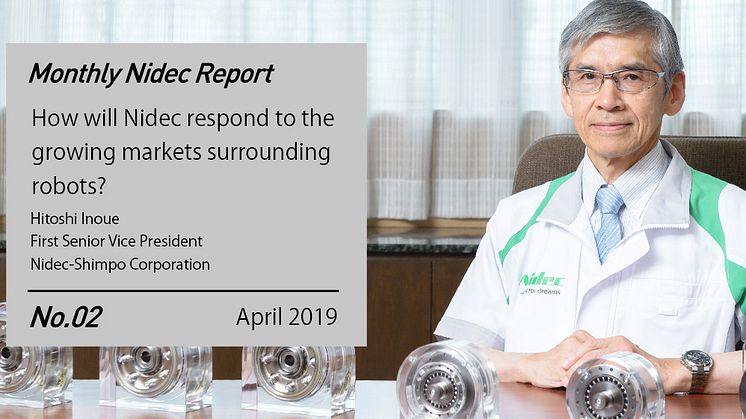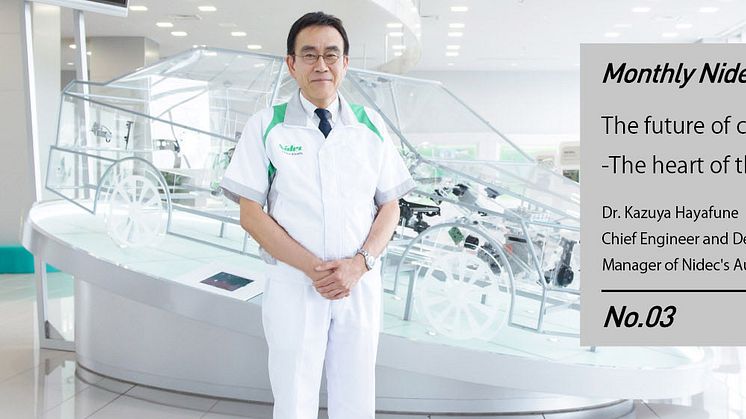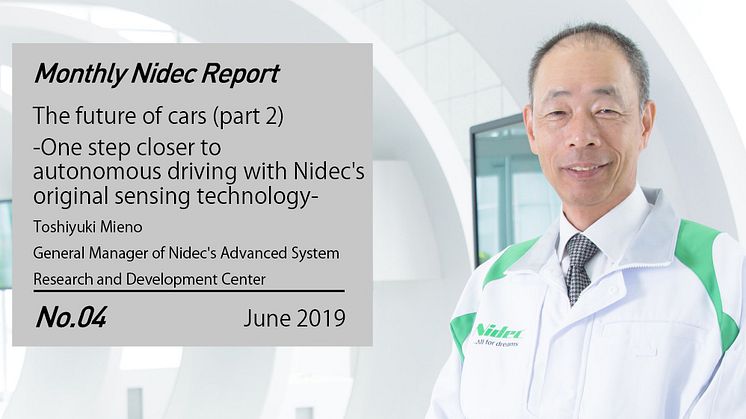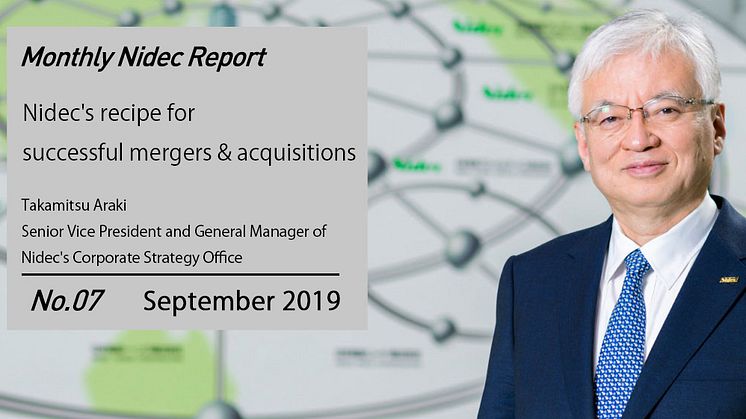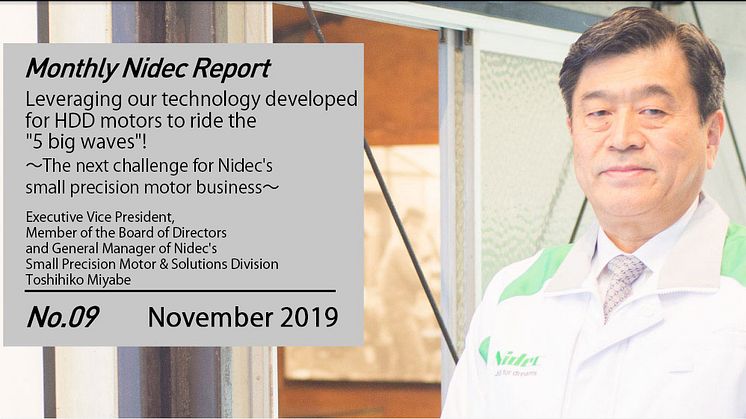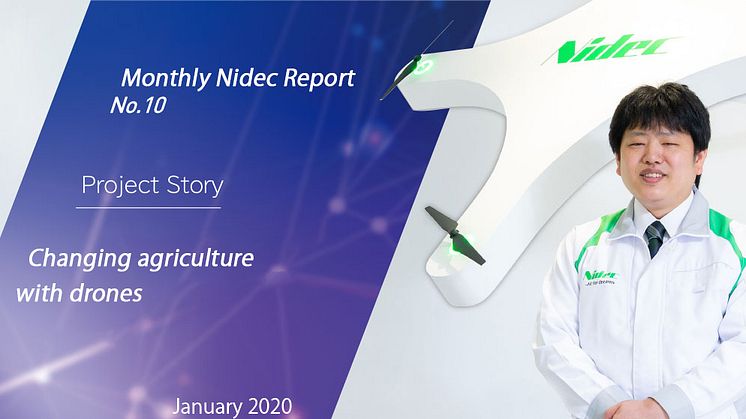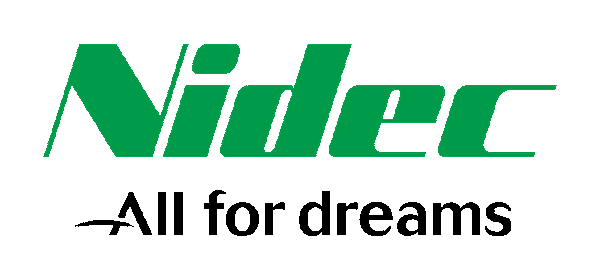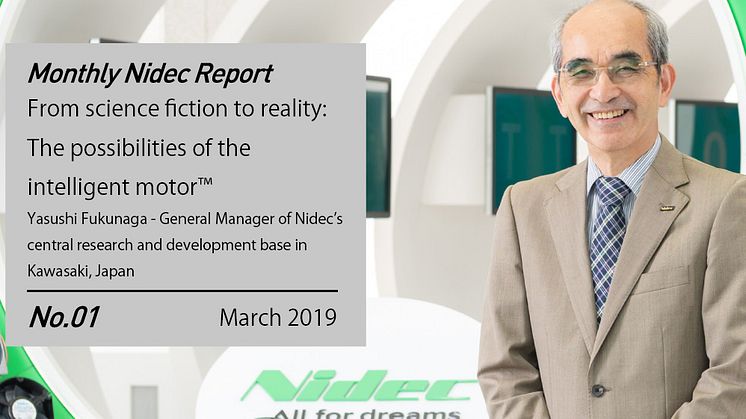
Blog post -
Monthly Nidec Report - From Science Fiction to Reality: The Possibilities of the Intelligent Motor™
Computers and home appliances, automobiles, and industrial robots—devices powered by motors permeate our society. What if we equipped all of these motors with microcomputers that allow not only precise control of their performance but also inter-motor communication and collaboration? How would society change? This is the question that sparked the development process leading up to the creation of Nidec’s Intelligent Motor™.
— What does it mean for a motor to be intelligent?
There is an animated children's television series in which steam locomotives talk to each other. One easy-to-understand way of thinking about the Intelligent Motor™ is to imagine something similar but with electric motors talking instead. For example, if one motor says "hey, I'm running out of lubrication oil and I'm starting to get a little tired," another one could reply with "all right, I'll work a bit harder and cover you then." In this way, motors could communicate with each other to solve problems and work more efficiently. Imagine if the motors inside all kinds of equipment in factories, for instance, could communicate like this and make adjustments to how they operate based on circumstantial awareness.
Furthermore, in addition to inter-motor communication, we could have motors connecting to, and taking directions from, other external devices as well. Similar motors have existed in the past, but by improving this technology we could take it one step further. How about turning on the air conditioner in your house on a hot summer day before you reach home for example? Other home appliances could be controlled remotely as well, opening up all kinds of possibilities. The evolution of motors improves quality of life by adding a little bit of convenience to our daily lives. The increase in operational efficiency also comes with the additional benefit of lower energy consumption.

— Can you tell us about the recent technological advances that have paved the way for the Intelligent Motor™?
The most significant advancement is the increase in processing power and decrease in price of microcomputers. Motors with built-in microcomputers have actually existed for a long time. For instance, in the 1970s in Japan you could buy an electric rice cooker with a motor that used a built-in 8-bit computer to adjust the heat based on the amount of rice used.
However, due to the (by today's standards) very low processing power of these computers, they were only fit for controlling the rotational speed of the motor and not much else. The computers used in the motors that we are currently developing, on the other hand, are 32-bit. At a first glance, 32-bit may not seem like a big step up from 8-bit, since 32 is only four times as much as 8. But, the 32 in "32-bit" actually refers to 232, 2 raised to the power of 32, and the difference between 28 and 232 in terms of processing power is monumental.
The price of microcomputers has changed dramatically as well. A computer with the same performance as a machine that would have cost JPY 300M (equivalent to almost USD 30M with today's exchange rate) 30 years ago can be bought today for as little as JPY 50 (less than half of USD 1). In addition, the microcomputers of today are lighter and smaller. As a result, it has become possible to outfit motors with powerful "brains" at a low cost.
— For how long has Nidec been developing the Intelligent Motor™?
The phrase Intelligent Motor™ was registered as a trademark in Japan by Nidec in 2007. Full-scale development focusing on motors with built-in microcomputers began around 2012. Shortly after, we established our "intelligent drive technology" that lets us control motors using microcomputers. This technology allows the computer to estimate the load of the motor and optimize operation by controlling the voltage, amperage and the rotational speed. What made it possible for us to succeed in developing this technology was our expertise that covers not only electric motors but also other components that are necessary when making motors intelligent, such as drives and sensors.

— How far has the technology progressed?
We are currently working on technology that allows us to control various types of motors of different sizes, from small motors to larger ones used by automobiles and industrial robots, using the same software. There are limits to what we can do with the current microcomputer technology, but when microprocessors with four times as much memory become available in the near future this will change. More memory gives us more room to add functions and features. The specific features that we add vary depending on the needs of each customer, so at the moment we are mostly focusing on developing new features that display the possibilities of the Intelligent Motor™ and spark the imagination of our customers.
— In December 2017, NEC and Nidec announced the joint development of a technology that can be used to wirelessly control multiple robots cooperatively. Can you describe this technology?
With the spread of IoT, remote control of robots through wireless networks has become possible, but real-time collaborative control of multiple robots has been fraught with issues.For example, due to wireless network communication lag, commands are delayed, causing the robots to move in a different way than intended. When the command that is being relayed reaches the motor, the initial conditions of the motor have already changed. What Nidec developed is a technology that lets the motors, or robots equipped with them, communicate closely with each other and synchronize their behavior with high precision. This technology was combined with communication delay prediction technology developed by NEC to make it possible to accurately control multiple robots remotely in real time. Tests that simulate the application of these technologies to Automated Guided Vehicles (AGVs) used in factories and warehouses show a 30% improvement in transportation efficiency.
— What are the benefits of being able to control multiple robots in real time?
By wirelessly connecting the motors inside AGVs with an external computer, acting as a command center, and sending rough commands like "follow a route similar to this," the motors inside a single AGV can communicate and cooperate not only with each other but also with motors in other AGVs. This makes it possible for multiple small AGVs to work in unison to carry a load that would normally require a larger AGV. For example, two AGVs that can each carry up to 100 kg (220 lbs) could work together to carry an object that weighs 200 kg (440 lbs). The motors would communicate with each other to overcome problems like uneven weight distribution or floor surface irregularities. This approach that combines small, and relatively inexpensive, AGVs increases flexibility and reduces costs.
NEC and Nidec develop technology to control robots equipped with Intelligent Motors™
— When do you expect that this new technology will be implemented?
We are aiming to implement the technology in actual products in FY2019. Nidec-Shimpo, a subsidiary of Nidec that manufactures AGVs among other products, is testing the technology in their products.
— How will consumers start feeling the impact of the Intelligent Motor™?
I imagine that the technology will first make itself known through household robots. Smart speakers with AI virtual assistants are getting more and more popular, especially in America where it is not uncommon to have these speakers set up in all of your rooms. It is not difficult to imagine a future in which the speakers have arms and legs (or wheels), equipped with these motors, and follow their owners around while receiving instructions. This may sound like something straight out of science fiction, but it could very well become reality soon.

— How will our lives and society change when things around us become equipped with motors that connect to each other wirelessly?
If motors can be used to collect information, we can analyze this big data to access new information or make previously unknown phenomena and trends visible. For example, real-time collection and analysis of data on the behavior of motors used in windscreen wipers on cars can give us accurate weather information such as where, and how much, it is raining at a given time. Analyzing the operational data of the traction motor that drives the wheels of the car can yield information about the conditions of the road; if the tires are not moving as they should in relation to the rotational speed of the motor, it could be an indication that the car is skidding. Knowledge of road conditions makes it easier to determine which route to take when sending relief goods after a natural disaster, for instance. Privacy is an important concern, of course, but I believe this type of technology will gain acceptance and see widespread use as people start understanding the societal benefits.

— What kind of development approach led to the creation of the Intelligent Motor™?
We start out by imagining how the society of the future will look, and base our research and development on this prediction. Market outlooks and current demand are not necessarily deciding factors when we choose the subject of our research, but, with that being said, as private sector researchers we do keep a business-oriented mind-set when we develop products based on our research into topics that interest us.
The city of Kawasaki, where this research and development center is located, is home to the research and development bases of around 350 different companies, mostly in the electronics and IT industry, and is sometimes referred to as "Japan's Silicon Valley." The joint research projects that we have worked on, such as the one with NEC, were born out of the lively inter-company exchange that marks this location. In the future, research and development based on increased cooperation between companies, research organizations and academic institutions, that involve people that collectively possess a diverse range of technical knowledge and skills, will be indispensable. What we are aiming for at this research and development center is this very thing: cooperative research. We are also hiring many researchers with backgrounds in different fields in order to adopt innovative new ideas.
— What are Nidec's strengths in terms of developing and launching new products?
Our biggest strength is that we manufacture over three billion motors of various sizes and types each year. When you supply such a large portion of the market, the technology that you develop inevitably becomes the de facto standard of the industry. Technological cross-pollination between the motors that we develop for different sectors and applications also gives us an edge over the competition.
Another asset is the combined strength of the companies that make up the Nidec group. Our group includes not only companies that manufacture motors and related components, like sensors and drives, but also compressor, presses and other machines that make use of motors. This allows us to offer modules that integrate many components in addition to stand-alone motors. In the six years that have passed since I became in charge of this research and development center, Nidec has gained 60-70 new factories and offices around the world through mergers and acquisitions. The combined global capabilities of our company group is one of the things that makes us strong. Our mission is to leverage these strengths to continue creating new innovative motors that will impact our lives and the industry, and change the world that we live in.

